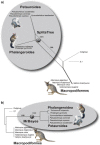Reunion of Australasian Possums by Shared SINE Insertions
- PMID: 35289914
- PMCID: PMC9366447
- DOI: 10.1093/sysbio/syac025
Reunion of Australasian Possums by Shared SINE Insertions
Abstract
Although first posited to be of a single origin, the two superfamilies of phalangeriform marsupial possums (Phalangeroidea: brushtail possums and cuscuses and Petauroidea: possums and gliders) have long been considered, based on multiple sequencing studies, to have evolved from two separate origins. However, previous data from these sequence analyses suggested a variety of conflicting trees. Therefore, we reinvestigated these relationships by screening $\sim$200,000 orthologous short interspersed element (SINE) loci across the newly available whole-genome sequences of phalangeriform species and their relatives. Compared to sequence data, SINE presence/absence patterns are evolutionarily almost neutral molecular markers of the phylogenetic history of species. Their random and highly complex genomic insertion ensures their virtually homoplasy-free nature and enables one to compare hundreds of shared unique orthologous events to determine the true species tree. Here, we identify 106 highly reliable phylogenetic SINE markers whose presence/absence patterns within multiple Australasian possum genomes unexpectedly provide the first significant evidence for the reunification of Australasian possums into one monophyletic group. Together, our findings indicate that nucleotide homoplasy and ancestral incomplete lineage sorting have most likely driven the conflicting signal distributions seen in previous sequence-based studies. [Ancestral incomplete lineage sorting; possum genomes; possum monophyly; retrophylogenomics; SINE presence/absence.].
© The Author(s) 2022. Published by Oxford University Press on behalf of the Society of Systematic Biologists.
Figures



References
-
- Avise J.C., Robinson T.J.. 2008. Hemiplasy: a new term in the lexicon of phylogenetics. Syst. Biol. 57:503-507. - PubMed
-
- Beck R.M.D. 2008. A dated phylogeny of marsupials using a molecular supermatrix and multiple fossil constraints. J. Mammal. 89:175-189.
-
- Churakov G., Sadasivuni M.K., Rosenbloom K.R., Huchon D., Brosius J., Schmitz J.. 2010. Rodent evolution: back to the root. Mol. Biol. Evol. 27:1315-1326. - PubMed
Publication types
MeSH terms
Associated data
LinkOut - more resources
Full Text Sources
Other Literature Sources

